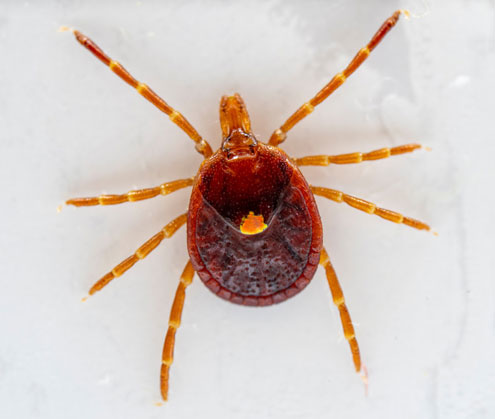Texas A&M AgriLife expert shares tips
to stay safe this tick season
As temperatures rise and Texans spend more time outdoors, the risk of tick bites increases across the state. It’s important to know how to spot, avoid and remove ticks in Texas, whether you’re hiking, camping, ranching or gardening.
Pete Teel, Ph.D., Texas A&M AgriLife Research entomologist and Regents Professor in the Texas A&M College of Agriculture and Life Sciences Department of Entomology, shares how to stay safe from ticks this season and why proper removal matters.
Most common tick species in Texas
“There are two common ticks in Texas: the Lone Star tick and the Gulf Coast tick,” Teel said.
Lone Star ticks are most active in late spring and throughout the summer. However, the Gulf Coast species is active year-round, especially in South Texas. Thus, these tick species are most active when outdoor activities are at their highest.
“Perhaps the most iconic human biting tick for Texas is the Lone Star tick, which gets its name from a single iridescent spot on the back of the adult female,” Teel said.
This tick has a wide host range, including many wildlife species and humans.
“You’ll most often encounter ticks when you enter their natural habitats,” Teel said. “This includes hiking, camping, trail riding or even ranching.”
To see more Texas tick species, visit Texas A&M AgriLife’s tick app.

Tick prevention and detection
Ticks are surprisingly good at finding their next host. “They can detect heat, carbon dioxide, shadows and vibrations,” Teel said.
The first stage after being hatched from eggs is the larval stage. The six-legged larvae, which can swarm in big groups, may leave tiny red spots that are so small they go unnoticed.
Nymphs and adults are eight-legged and slightly larger than larvae, making these stages easier to see. However, they can still transmit disease-causing pathogens if they are not removed.
Teel recommends the following prevention steps to spot, avoid and remove ticks:
- Wear light colored clothing to help spot ticks.
- Tuck pants into boots or socks when walking through tall grass or brush.
- Consider using masking tape barriers made by folding tape lengthwise and wrapping around your tucked pant legs with the sticky side facing out to trap ticks as they crawl.
- Apply EPA-approved tick repellent.
- Conduct inspections for attached ticks.
- Properly remove attached ticks and hold them for observation.
“Always perform a tick check after outside activities. This can be for humans and your furry loved ones,” Teel said.
He explained a proper tick check inspection includes behind the ears, on the scalp, the waistline and under the arms.
How to safely remove a tick
“When removing a tick, it is important to not twist, jerk, burn or douse with chemicals because this may cause the tick to spit pathogens into the bite, causing a tick-borne illness,” Teel said.
Instead, he recommended following these steps:
- Use fine-tipped tweezers or a tick-removal tool to grasp the tick as close to the skin as possible.
- Pull straight out with steady, even pressure.
- Clean the area with an alcohol swab or antiseptic after removing the whole tick.
Teel said once the tick is removed, consider placing it in a closed bottle or bag and saving it. Ticks removed from Texas citizens can be submitted for identification and for tick-borne pathogen testing for free of charge to the Texas Department of State Health Services.
“Awareness and prompt action go a long way in preventing a tick-borne illness,” Teel said. “Know how to avoid ticks and how to properly remove them.”
More tick talk
To learn more and see maps of where tick species live in Texas and across the U.S., visit the Centers for Disease Control and Prevention’s page about where ticks live.
SEE WHERE TICKS LIVE

